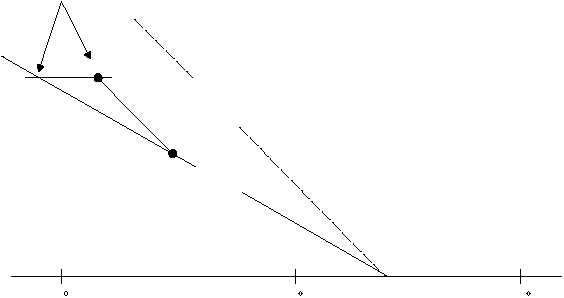saturation adiabatic lapse rate. Upon arriving at point B
the parcel is then warmer than the surrounding air. For
this reason, it has a tendency to continue moving farther
from its original position. The parcel, therefore, is in a
state of INSTABILITY. The following rule is
applicable. If the actual lapse rate for a column of
SATURATED (MOIST) AIR is greater than the
saturation adiabatic lapse rate, the column is unstable.
NEUTRAL STABILITY.—Consider a column of
saturated air in which the actual lapse rate is equal to the
saturation adiabatic lapse rate. A parcel of air displaced
upward cools at the saturation adiabatic lapse rate and
is at all times equal in temperature to the surrounding
air. On that account it tends neither to move farther
away from nor to return to its original level. Therefore,
it is in a state of NEUTRAL STABILITY. The rule for
this situation is that if the actual lapse rate for a column
of saturated air is equal to the saturation adiabatic lapse
rate, the column is neutrally stable.
Conditional Instability
In the treatment of stability and instability so far,
only air that was either dry or saturated was considered.
Under normal atmospheric conditions natural air is
unsaturated to begin with, but becomes saturated if
lifted high enough. This presents no problem if the
actual lapse rate for the column of air is greater than the
dry adiabatic lapse rate (absolutely unstable) or if the
actual lapse rate is less than the saturation adiabatic
lapse rate (absolutely stable). However, if the lapse rate
for a column of natural air lies between the dry
adiabatic lapse rate and the saturation adiabatic lapse
rate, the air may be stable or unstable, depending upon
the distribution of moisture. When the actual lapse rate
of a column of air lies between the saturation adiabatic
lapse rate and the dry adiabatic lapse rate, the
equilibrium
is
termed
CONDITIONAL
INSTABILITY, because the stability is conditioned by
the moisture distribution. The equilibrium of this
column of air is determined by the use of positive and
negative energy areas as analyzed on a Skew-T, Log P
diagram. The determination of an area as positive or
negative depends upon whether the parcel is being
lifted mechanically (by a front or orographic barriers)
or by convective means and whether the environment is
colder or warmer than the ascending parcel. Positive
areas are conducive to instability. Negative areas are
conducive to stability.
Conditional instability may be one of three types.
The REAL LATENT type is a condition in which the
positive area is larger than the negative area (potentially
unstable). The PSEUDOLATENT type is a condition in
which the positive area is smaller than the negative area
(potentially STABLE). The STABLE type is a
condition in which there is no positive area. Figure
2-19
AG5f0213
-10
0
10
B
SATURATION
ADIABATIC
LAPSE RATE
ACTUAL
LAPSE
RATE
POINT B WARMER THAN
THE SURROUNDING AIR
A
Figure 2-13.—Instability (saturated air).


